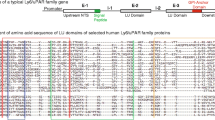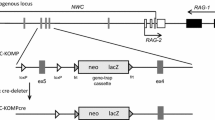Abstract
The murine Xlr (X-linked, lymphocyte-regulated) gene family was originally identified by subtractive cDNA hybridization and cloning. It was found to encode two 30-kDa nuclear proteins expressed in lymphoid cells and in primary spermatocytes in a developmentally regulated manner. Our data show that, in contrast to most X-linked genes, the Xlr family is not conserved at the DNA level between mouse and human. However, using anti-Xlr antibodies, an Xlr-immunoreactive nuclear protein of Mr 30,000 was characterized in human RAJI B-lymphoblastoid cells by flow cytofluorimetry, by immunoblotting, and by immuno-cytolabeling. An Xlr-like molecule was also found to be expressed in human activated lymphocytes and in human primary spermatocytes, with a stage specificity similar to that known in the mouse. In contrast, no Xlr-immunoreactive protein was detected in a series of human tissues including brain, skeletal muscle, colon, liver, and kidney, revealing a tissue-specific expression pattern similar to that of murine Xlr. These findings most likely identify a human equivalent of Xlr. The Xlr genes belong to a small category of X-linked genes, including STS, MIC2, CSF2RA, and KAL, that diverge at the DNA level in human and in mice. Characterization of the human XLR gene(s) should now be feasible with anti-Xlr antibodies and an expression cloning system. It should provide new insights into the evolution of mammalian X Chromosome (Chr).
Similar content being viewed by others
References
Bergsagel, P.L., Timblin, C.R., Kozak, C.A., Kuehl, W.M. (1994). Sequence and expression of murine cDNAs encoding Xlr3a and Xlr3b, defining a new X-linked lymphocyte-regulated Xlr gene subfamily. Gene 150, 345–350.
Blair, H.J., Reed, V., Laval, S.H., Boyd, Y. (1994). New insights into the man-mouse comparative map of the X chromosome. Genomics 19, 215–220.
Calenda, A., Allenet, B., Escalier, D., Bach, J.-F., Garchon, H.-J. (1994). The meiosis-specific Xmr gene product is homologous to the lymphocyte Xlr protein and is a component of the XY body. EMBO J 13, 100–109.
Cohen, D.I., Hedrick, S.M., Nielsen, E.A., D'Eustachio, P., Ruddle, F., Steinberg, A.D., Paul, W.E., Davis, M.M. (1985a). Isolation of a cDNA clone corresponding to an X-linked gene family (XLR) closely linked to the murine immunodeficiency disorder xid. Nature 314, 369–372.
Cohen, D.I., Steinberg, A.D., Paul, W.E., Davis, M.M. (1985b). Expression of an X-linked gene family (XLR) in late-stage B cells and its alteration by the xid mutation. Nature 314, 372–374.
De Saiut Basile, G., Fischer, A. (1991). X-linked immunodeficiencies: clues to genes involved in T- and B-cell differentiation. Immunol. Today 12, 456–461.
Disteche, C.M., Brannan, C.I., Larsen, A., Adler, D.A., Schorderet, D.F., Gearing, D., Copeland, N.G., Jenkins, N.A., Park, L.S. (1992). The human pseudoautosomal GM-CSF receptor alpha-subunit gene is autosomal in mouse. Nature Genet. 1, 333–336.
Dobson, M.J., Pearlman, R.E., Karaiskakis, A., Spyropoulos, B., Moens, P.B. (1994). Synaptonemal complex proteins: occurrence, epitope mapping and chromosome disjunction. J. Cell Sci. 107, 2749–2760.
Feinberg, A.P., Vogelstein, B. (1983). A technique for radiolabeling DNA restriction endonuclease fragments to high specific activity. Anal. Biochem. 132, 6–13.
Fischer, A. (1993). Primary T-cell immunodeficiencies. Curr. Opin. Immunol. 5, 569–578.
Franco, B., Guioli, s., Pragliola, A., Incerti, B., Bardoni, B., Tonlorenzi, R., Carrozzo, R., Maestrini, E., Pieretti, M., Taillon Miller, P., Brown, C.J., Willard, H.F., Lawrence, C., Persico, M.G., Camerino, G., Ballabio, A. (1991). A gene deleted in Kallmann's syndrome shares homology with neural cell adhesion and axonal path-finding molecules. Nature 353, 529–536.
Garchon, H.-J. (1991). The Xlr (X-linked lymphocyte-regulated) gene family. A candidate locus for an X-linked primary immunodeficiency. Immunodefic. Rev. 2, 283–302.
Garchon, H.-J., Davis, M.M. (1989). The XLR gene product defines a novel set of proteins stabilized in the nucleus by zinc ions. J. Cell Biol. 108, 779–787.
Garchon, H.-J., Loh, E., Ho, W.Y., Amar, L., Avner, P., Davis, M.M. (1989). The XLR sequence family: dispersion on the X and Y chromosomes of a large set of closely related sequences, most of which are pseudogenes. Nucleic Acids Res. 17, 9871–9888.
Goodfellow, P.J., Darling, S.M., Thomas, N.S., Goodfellow, P.N. (1986). A pseudoautosomal gene in man. Science 234, 740–743.
Gough, N.M., Gearing, D.P., Nicola, N.A., Baker, E., Pritchard, M., Callen, D.F., Sutherland, G.R. (1990). Localization of the human GM-CSF receptor gene to the X-Y pseudoautosomal region. Nature 345, 734–736.
Hammarström, L., Gillner, M., Edvard Smith, C.I. (1993). Molecular basis for human immunodeficiencies. Curr. Opin. Immunol. 5, 579–584.
Hartung, M., Wachtler, F., de Lanversin, A., Fouet, C., Schwarzacher, H.G., Stahl, A. (1990). Sequential changes in the nucleoli of human spermatogonia with special reference to rDNA location and transcription. Tissue Cell 22, 25–37.
Herman, G.E., Boyd, Y., Chapman, V., Chatterjee, A., Brown, S.D.M. (1994). Mouse X-chromosome. Mamm. Genome 5(Suppl.), S276-S288.
Keitges, E., Rivest, M., Siniscalco, M., Gartler, S.M. (1985). X-linkage of steroid sulphatase in the mouse is evidence for a functional Y-linked allele. Nature 315, 226–227.
Lammers, J.H., Offenberg, H.H., Van Aalderen, M., Vink, A.C., Dietrich, A.J., Heyting, C. (1994). The gene encoding a major component of the lateral elements of synaptonemal complexes of the rat is related to X-linked lymphocyte-regulated genes. Mol. Cell. Biol. 14, 1137–1146.
Laval, S.H., Boyd, Y. (1993a). Novel sequences conserved on the human and mouse X-chromosomes. Genomics 15, 483–491.
Laval, S.H., Boyd, Y. (1993b). Partial inversion of gene order within a homologous segment on the X-chromosome. Mamm. Genome 4, 119–123.
Legouis, R., Hardelin, J.-P., Levilliers, J., Claverie, J.-M., Compain, S., Wunderle, V., Millasseau, P., Le Paslier, D., Cohen, D., Caterina, D., Bougueleret, L., Delemaare-Van de Waal, H., Lutfalla, G., Weissenbach, J., Petit, C. (1991). The candidate gene for the X-linked Kallmann syndrome encodes a protein related to adhesion molecules. Cell 67, 423–435.
Legouis, R., Cohen-Salmon, M., Del Castillo, I., Levilliers, J., Capy, L., Mornow, J.P., Petit, C. (1993). Characterization of the chicken and quail homologues of the human gene responsible for the X-linked Kallmann syndrome. Genomics 17, 516–518.
Lyon, M.F., Peters, J., Glenister, P.H., Ball, S., Wright, E. (1990). The scurfy mouse mutant has previously unrecognized hematological abnormalities and resembles Wiskott-Aldrich syndrome. Proc. Natl. Acad. Sci. USA 87, 2433–2437.
Mandel, J.L., Monaco, A.P., Nelson, D.L., Schlessinger, D., Willard, H. (1992). Genome analysis and the human X-chromosome. Science 258, 103–109.
Mullins, L.J., Stephenson, D.A., Grant, S.G., Chapman, V.M. (1990). Efficient linkage of 10 loci in the proximal region of the mouse x-chromosome. Genomics 7, 19–30.
Nasir, J., Fisher, E.M.C., Brockdorff, N., Disteche, C.M., Lyon, M.F., Brown, S.D.M. (1990). Unusual molecular characteristics of a repeat sequence island within a Giemsa-positive band on the mouse X chromosome. Proc. Natl. Acad. Sci. USA 87, 399–403.
O'Brien, S.J., Peters, J., Searle, A., Womack, J., Marshall Graves, J. (1993). Report of the Committee on Comparative Gene Mapping. In Chromosome Coordinating Meeting 1992, A.J. Cuticchia, P.L. Pearson, eds. (CH-4009 Basel: Karger), pp 758–809.
Ohno, S. (1969). Evolution of sex chromosomes in mammals. Annu. Rev. Genet. 3, 495–524.
Park, L.S., Martin, U., Sorensen, R., Luhr, S., Morrissey, P.J., Cosman, D., Larsen, A. (1992). Cloning of the low-affinity murine granulocyte-macrophage colony-stimulating factor receptor and reconstitution of a high-affinity receptor complex. Proc. Natl. Acad. Sci. USA 89, 4295–4299.
Rawlings, D.J., Saffran, D.C., Tsukada, S., Largaespada, D.A., Grimaldi, J.C., Cohen, L., Mohr, R.N., Bazan, J.F., Howard, M., Copeland, N.G., Jenkins, N.A., Witte, O.N. (1993). Mutation of unique region of Bruton's tyrosine kinase in immunodeficient XID mice. Science 261, 358–361.
Rugarli, E.I., Lutz, B., Kuratani, S.C., Wawersik, S., Borsani, G., Ballabio, A., Eichele, G. (1993). Expression of the Kallmann syndrome gene in the olfactory system suggests a role in neuronal targeting. Nature Genet 4, 19–26.
Sambrook, J., Fritsch, E.F., Maniatis, T. (1989). Molecular Cloning: A Laboratory Manual, 2nd ed. (Cold Spring Harbor, N.Y.: Cold Spring Harbor Laboratory Press).
Scher, I. (1982). The CBA/N mouse strain: an experimental model illustrating the influence of the X-chromosome on immunity. Adv. Immunol. 33, 1–71.
Siegel, J.N., Turner, C.A., Klinman, D.M., Wilkinson, M., Steinberg, A.D., MacLeod, C.L., Paul, W.E., Davis, M.M., Cohen, D.I. (1987). Sequence analysis and expression of an X-linked, lymphocyte-regulated gene family (XLR). J. Exp. Med. 166, 1702–1715.
Thomas, J.D., Sideras, P., Smith, C.I.E., Vorechovsky, I., Chapman, V., Paul, W.E. (1993). Colocalization of X-linked agammaglobulinemia and X-linked immunodeficiency genes. Science 261, 355–358.
Yen, P.H., Allen, E., Marsh, B., Mohandas, T., Wang, N., Taggart, R.T., Shapiro, L.J. (1987). Cloning and expression of steroid sulfatase cDNA and the frequent occurrence of deletions in STS deficiency: implications for X-Y interchange. Cell 49, 443–454.
Author information
Authors and Affiliations
Rights and permissions
About this article
Cite this article
Allenet, B., Escalier, D. & Garchon, H.J. A putative human equivalent of the murine Xlr (X-linked, lymphocyte-regulated) protein. Mammalian Genome 6, 640–644 (1995). https://doi.org/10.1007/BF00352372
Received:
Accepted:
Issue Date:
DOI: https://doi.org/10.1007/BF00352372




